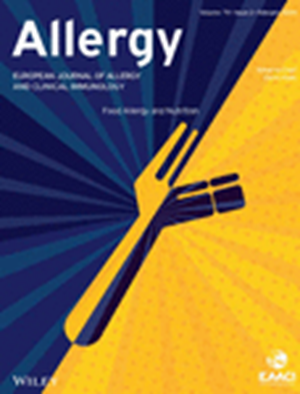Direct Single-Dose Drug-Provocation Test Is Safe for Delabelling Penicillin Low-Risk Reactions in Adults.
IF 12
1区 医学
Q1 ALLERGY
引用次数: 0
Abstract
BACKGROUND Penicillins (PENs) are the most frequent drug-allergic reactions trigger. However, diagnostic work-up is complex and time-consuming: it requires skin testing (ST) and drug-provocation test (DPT), needing faster delabelling strategies. Although direct DPT without previous STs has shown to be safe, most of the studies are performed in children or in North American, Asian, or Oceanian adults, with few studies in the European adult population. We explored its safety in European adult patients with low-risk PEN allergy history and, additionally, analysed ST role and T-cell involvement by lymphocyte transformation test (LTT). METHODS We prospectively evaluated > 16 years of PEN-allergic labelled patients referred to Málaga Regional University Hospital during 2023. They reported non-immediate reactions without alarm signs and unknown reactions. Direct-single-dose DPT was performed in all patients. If positive, ST and LTT were carried out after reaction resolution. RESULTS We included 269 patients with the culprits being an unidentified PEN (36%), amoxicillin (AX) (32%), and AX-clavulanic acid (AX-CLV) (31%); and the symptoms maculopapular exanthema (MPE) (34%) and unknown reaction during childhood (23%). Only 16 (5.9%) had positive DPT, being 56% for AX and 44% for AX-CLV, 81% developing MPE, none severe. Most DPT-reacting patients reported cutaneous non-immediate reactions in the index reaction, and only one had an unknown childhood reaction. The mean day interval between drug administration and symptom development was lower (p = 0.002) in positive DPT than in the index reaction (2 vs 5 days). Moreover, ST was positive in only 19% and LTTs in 86.7% of positive DPT patients. CONCLUSIONS Direct-single-dose DPT is safe for delabelling PEN allergy in non-immediate reactions without alarm signs and unknown reactions. ST had a poor diagnostic value and LTT had a high one, confirming a T-cell involvement.直接单剂量药物激发试验可安全用于成人青霉素低风险反应。
背景:青霉素类药物(PENs)是最常见的药物过敏反应触发器。然而,诊断检查是复杂和耗时的:它需要皮肤试验(ST)和药物激发试验(DPT),需要更快的去标签策略。虽然没有既往STs的直接DPT已被证明是安全的,但大多数研究是在儿童或北美、亚洲或大洋洲的成年人中进行的,在欧洲成年人中进行的研究很少。我们探讨了其在具有低风险PEN过敏史的欧洲成年患者中的安全性,此外,通过淋巴细胞转化试验(LTT)分析了ST的作用和t细胞的参与。方法前瞻性评估2023年期间在Málaga地区大学医院转诊的bbb16年的笔过敏标签患者。他们报告了非立即反应,没有警报信号和未知反应。所有患者均行直接单剂量DPT。若阳性,反应分解后进行ST和LTT检测。结果纳入269例患者,其罪魁祸首为未知的PEN(36%)、阿莫西林(32%)和AX-克拉维酸(31%);黄斑丘疹(MPE)症状(34%)和儿童期未知反应(23%)。只有16例(5.9%)DPT阳性,其中56%为AX, 44%为AX- clv, 81%为MPE,无严重。大多数dpt反应患者在指数反应中报告皮肤非立即反应,只有一人有未知的儿童反应。DPT阳性组给药至症状出现的平均间隔时间(2天vs 5天)低于指标反应组(p = 0.002)。此外,在DPT阳性患者中,ST阳性率仅为19%,ltt阳性率为86.7%。结论直接单剂量DPT治疗PEN过敏非立即反应是安全的,无报警体征和未知反应。ST的诊断价值较低,而LTT的诊断价值较高,证实了t细胞的参与。
本文章由计算机程序翻译,如有差异,请以英文原文为准。
求助全文
约1分钟内获得全文
求助全文
来源期刊

Allergy
医学-过敏
CiteScore
26.10
自引率
9.70%
发文量
393
审稿时长
2 months
期刊介绍:
Allergy is an international and multidisciplinary journal that aims to advance, impact, and communicate all aspects of the discipline of Allergy/Immunology. It publishes original articles, reviews, position papers, guidelines, editorials, news and commentaries, letters to the editors, and correspondences. The journal accepts articles based on their scientific merit and quality.
Allergy seeks to maintain contact between basic and clinical Allergy/Immunology and encourages contributions from contributors and readers from all countries. In addition to its publication, Allergy also provides abstracting and indexing information. Some of the databases that include Allergy abstracts are Abstracts on Hygiene & Communicable Disease, Academic Search Alumni Edition, AgBiotech News & Information, AGRICOLA Database, Biological Abstracts, PubMed Dietary Supplement Subset, and Global Health, among others.
 求助内容:
求助内容: 应助结果提醒方式:
应助结果提醒方式:


